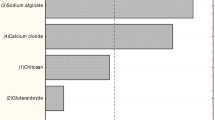Summary
A short time after the immobilization of Escherichia coli in calcium alginate substantial modifications of the fatty acid patterns of the cells were observed. This effect could be related to lipid impurities in the commercial alginate product used, which could be taken up, at least in part by the microorganisms. The impurities were mainly free fatty acids but sterols were also detected. Immobilization of the cells in alginate material extracted by chloroform or ethanol decreased the tolerance of the cells to phenol as compared with cells immobilized in raw alginate. This effect was diminished if the immobilized cells were exogenously supplied with palmitic acid, which is the main constituent of the fatty acids extracted from alginate. These results indicate that not only fatty acids but also other ingredients of commercial alginate have physiological effects on cells entrapped in this gel material.
Similar content being viewed by others
References
Bligh EG, Dyer WJ (1959) A rapid method of total lipid extraction and purification. Can J Biochem Physiol 37:911–917
Cronan JE, Rock CO (1987) Biosynthesis of membrane lipids. In: Neidhardt FC (ed) Escherichia coli and Salmonella typhimurium cellular and molecular biology, vol 1. American Society for Microbiology, Washington, D.C., pp 474–497
Curtain CC (1986) Understanding and avoiding ethanol inhibition. Trends Biotechnol 4:110
Davidson PM, Branen AL (1981) Antimicrobial activity of non-halogenated phenolid compounds. J Food Prot 44:623–632
Diefenbach R (1990) Einfluss von Fettsäuren auf Membran und Phenoltoleranz freier und immobilisierter Zellen von Escherichia coli. Diploma thesis, University of Münster
Eikmeier H, Rehm HJ (1987) Stability of calcium-alginate during citric acid production of immobilized Aspergillus niger. Appl Microbiol Biotechnol 26:105–111
Gacesa P (1988) Alginates. Carbohydr Polym 8:1162–182
Goodwin TW (1974) Sterols. In: Stewart WDP (ed) Algal physiology and biochemistry, Blackwell Scientific Publications, Oxford, pp 266–280
Heipieper HJ, Keweloh H, Rehm HJ (1991) Influence of phenols on growth and membrane permeability of free and immobilized Escherichia coli. Appl Environ Microbiol 57:1213–1217
Holcberg IB, Margalith P (1981) Alcoholic fermentation by immobilized yeast at high sugar concentrations. Eur J Appl Microbiol Biotechnol 13:133–140
Kaluzny MA, Duncan LA, Merritt MV, Epps DE (1985) Rapid separation of lipid classes in high yield and purity using bonded phase columns. J Lipid Res 26:135–140
Kennedy JF, Cabral JMF (1983) Immobilized cells and their application. In: Chibata I, Wingard LB (eds) Immobilized microbial cells. Academic Press, New York, pp 189–280
Keweloh H, Heipieper HJ, Rehm HJ (1989) Protection of bacteria against toxicity of phenol by immobilization in calcium alginate. Appl Microbiol Biotechnol 31:383–389
Keweloh H, Weyrauch G, Rehm HJ (1990) Phenol-induced membrane changes in free and immobilized Escherichia coli. Appl Microbiol Biotechnol 33:66–71
Keweloh H, Diefenbach R, Rehm HJ (1991) Increase of phenol tolerance of Escherichia coli by alterations of the fatty acid composition of the membrane lipids. Arch Microbiol, in press
Mattiasson B (1983) Immobilized viable cells. In: Mattiasson B (ed) Immobilized cells and organelles, vol II. CRC press, Boca Raton, Fla., pp 23–39
Mattiasson B, Hahn-Hägerdal B (1982) Microenvironmental effects on metabolic behavior of immobilized cells: a hypothesis. Eur J Appl Microbiol Biotechnol 16:52–55
Morrison WR, Smith LM (1964) Preparation of fatty acid methyl esters and dimethylacetals from lipids with boron fluoride-methanol. J Lipid Res 5:600–608
Rock CO, Jackowski S (1985) Pathways for the incorporation of exogenous fatty acids into phosphatidylethanolamine in Escherichia coli. J Biol Chem 260:12720–12724
Skjak-Braek G, Murano E, Paoletti S (1989) Alginate as immobilization material. II. Determination of polyphenol contaminants by fluorescence spectroscopy, and evaluation of methods for their removal. Biotechnol Bioeng 33:90–94
Wood BJB (1974) Fatty acids and saponifiable lipids. In: Steward WDP (ed) Algal physiology and biochemistry, Blackwell Scientific Publications, Oxford, pp 236–265
Author information
Authors and Affiliations
Additional information
Offprint requests to: H.-J. Rehm
Rights and permissions
About this article
Cite this article
Diefenbach, R., Keweloh, H. & Rehm, HJ. Fatty acid impurities in alginate influence the phenol tolerance of immobilized Escherichia coli . Appl Microbiol Biotechnol 36, 530–534 (1992). https://doi.org/10.1007/BF00170197
Received:
Accepted:
Issue Date:
DOI: https://doi.org/10.1007/BF00170197




